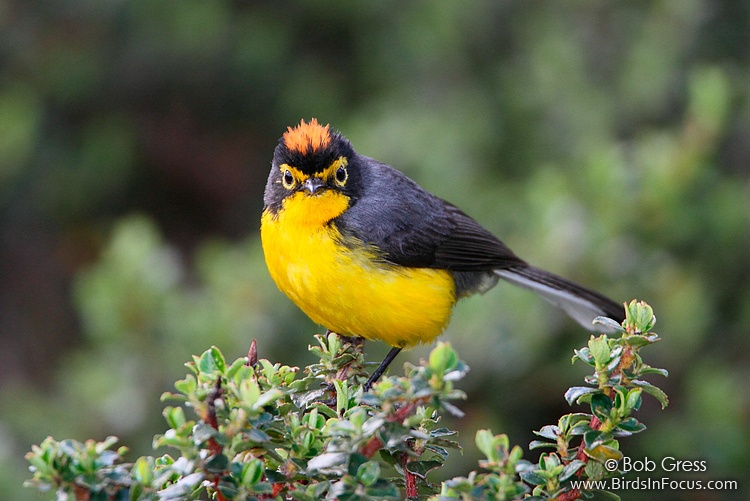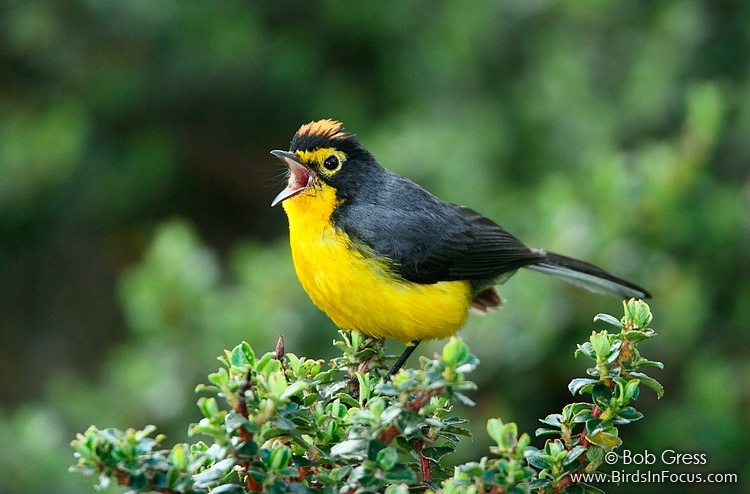Spectacled Whitestart
Glasses Warbler ( subspecies Myioborus m. Ruficoronatus )
The glasses Warbler ( Myioborus melanocephalus ) is a small passerine bird in the genus Myioborus in the family of warblers ( Parulidae ). The species forms with the black ear - Warbler ( Myioborus ornatus ) is a super species to which possibly the White-fronted Warbler ( Myioborus albifrons ) and the Salvin Warbler ( Myioborus flavivertex ) belong. The distribution area of the spectacle warbler is located in South America (Colombia, Ecuador, Peru and Bolivia). From the IUCN he is "not at risk " out ( least concern ).
Features
Glasses Warbler reach a body length of 13.0 to 13.5 centimeters. The wing length in males from 6.1 to 7.4 inches; in females from 6.3 to 7.0 centimeters. In the nominate the crown and the reins are black in adult rats and chicks from the first year and the ear-coverts blackish; backwards into the neck area it runs out gray. The striking yellow eyes rings, which are often connected by a narrow yellow band across the forehead which form a prominent glasses. The neck, the sides of the neck and the top feathers with a slightly olive toned jacket are dark gray. The wings are blackish with narrow gray feather edges. The underside is yellow plumage, the tail is blackish with white outer feathers and the under tail-coverts are white. The beak and legs are blackish.
Resources, nutrition and reproduction
Glasses Warbler are resident birds that change is limited within the altitudes. They live at altitudes of 2000-3300 meters, cloud forests, moist mountain forests and forest edges and the adjoining bushes. They are often observed near the tree line. In their raids usually form small family groups or groups that are often associated with other species of birds. Their diet consists of insects and other invertebrates. This they are looking for in the higher elevations of trees, mostly in the canopy, they begin as the flycatchers from a waiting or search above the bushes. Sometimes they are also observed at heights of 2 meters in the trees in search of food. When meeting with the larvae Warbler ( Myioborus miniatus ) show Glasses Warbler often aggressive behavior.
There are no studies to nest. Maybe it is similar to the closely related Black ear - warbler. Also no exact breeding seasons, breeding and nestling periods are known. A clutch usually consists of two eggs. This conclusion stems from the fact that it has been observed several family associations in mid-February near Cuenca in Ecuador; the parents usually fed two fledgling fledglings. More sightings of fledged young birds there were in March, April, June, July and September in northwestern Ecuador and in February and March in the Amazon in Peru, in June and December in central Peru and in January in La Paz in Bolivia.
Subspecies and distribution
There are five recognized subspecies:
- Myioborus m. melanocephalus ( Tschudi, 1844) - Widespread in central Peru.
- Myioborus m. ruficoronatus ( Kaup, 1852) - Occurs in Ecuador and in the extreme southwest of Colombia. The subspecies differs from Myioborus m. griseonuchus by the larger reddish- brown crown patch and the yellow sub beard area.
- Myioborus m. bolivianus Chapman, 1919 - deposits are found in the south of Peru and west central Bolivia. Is slightly narrower than the nominate form and the yellow underside plumage is somewhat paler.
- Myioborus m. griseonuchus Chapman, 1927 - Widespread in northwestern Peru. The subspecies has a narrower reddish- brown crown patch as Myioborus m. ruficoronatus.
- Myioborus m. malaris Room, 1949 - May occur in the north of Peru. Similar to the nominate form. The ear-coverts are more black and also of the beard area is black.










